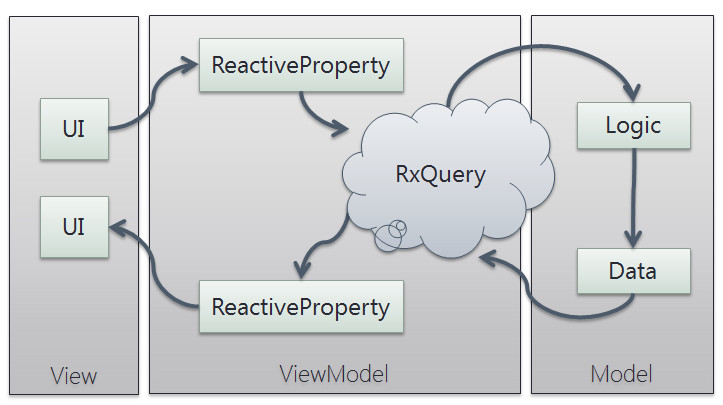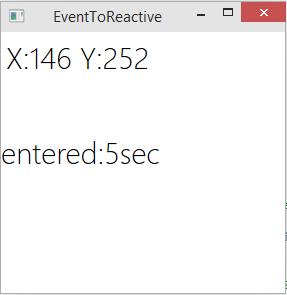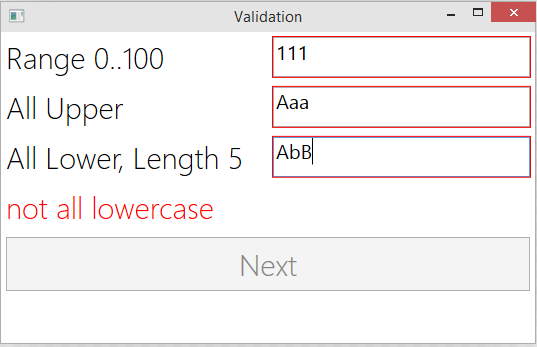ReactiveProperty is MVVM and Asynchronous Extensions for Reactive Extensions. Target Framework is .NET 4.0 Client Profile, .NET 4.5, Windows Phone 8.0/8.1, Windows store app 8.0/8.1, Xamarin.iOS, Xamarin.Android.
- ReactiveProperty - Two-way bindable IObservable, from V to VM and VM to V.
- ReactiveCommand - Convert observable condition sequence to ICommand
- Typesafe convert INotifyPropertyChanged to ReactiveProperty
- Event to ReactiveProperty Blend trigger
- There means V -> VM -> M -> VM -> V completely connected in reactive, everything is asynchronous
- NuGet installation support.
- PM > Install-Package ReactiveProperty
- ReactiveProperty makes viewmodel extermely clean
Note: ReactiveProperty is not replace existing MVVM Framework. ReactiveProperty no provides ViewModelBase, Messenger, etc. I recommend that use MVVM Framework together.
Install NuGet.
PM > Install-Package ReactiveProperty
<StackPanel>
<TextBlock>Appears chracter after 1 second.</TextBlock>
<!-- ReactiveProperty binding ".Value" -->
<TextBox Text="{Binding InputText.Value, Mode=TwoWay, UpdateSourceTrigger=PropertyChanged}" />
<TextBlock Text="{Binding DisplayText.Value}" />
<Button Command="{Binding ReplaceTextCommand}">Is TextBox empty or not?</Button>
</StackPanel>// ReactiveProperty and ReactiveCommand simple example.
public class ReactivePropertyBasicsViewModel
{
public ReactiveProperty<string> InputText { get; private set; }
public ReactiveProperty<string> DisplayText { get; private set; }
public ReactiveCommand ReplaceTextCommand { get; private set; }
public ReactivePropertyBasicsViewModel()
{
// mode is Flags. (default is all)
// DistinctUntilChanged is no push value if next value is same as current
// RaiseLatestValueOnSubscribe is push value when subscribed
var allMode = ReactivePropertyMode.DistinctUntilChanged | ReactivePropertyMode.RaiseLatestValueOnSubscribe;
// binding value from UI Control
// if no set initialValue then initialValue is default(T). int:0, string:null...
InputText = new ReactiveProperty<string>(initialValue: "", mode: allMode);
// send value to UI Control
DisplayText = InputText
.Select(s => s.ToUpper()) // rx query1
.Delay(TimeSpan.FromSeconds(1)) // rx query2
.ToReactiveProperty(); // convert to ReactiveProperty
ReplaceTextCommand = InputText
.Select(s => !string.IsNullOrEmpty(s)) // condition sequence of CanExecute
.ToReactiveCommand(); // convert to ReactiveCommand
// ReactiveCommand's Subscribe is set ICommand's Execute
// ReactiveProperty.Value set is push(& set) value
ReplaceTextCommand.Subscribe(_ => InputText.Value = "Hello, ReactiveProperty!");
}
}ReactiveProperty's direct binding is very simple and clear syntax.
<Window.Resources>
<vm:Converters x:Key="Converters" />
</Window.Resources>
<Grid>
<!-- Use Blend SDK's Interaction Trigger -->
<!-- Event binding to ReactiveProperty -->
<i:Interaction.Triggers>
<i:EventTrigger EventName="MouseMove">
<!-- ConvertBack function is Func<object, object>-->
<r:EventToReactive ReactiveProperty="{Binding MouseMove}"
Converter="{Binding MouseEventToPoint, Source={StaticResource Converters}}" />
</i:EventTrigger>
<i:EventTrigger EventName="MouseDown">
<!-- direct event bind -->
<r:EventToReactive ReactiveProperty="{Binding MouseDown}" IgnoreEventArgs="True" />
</i:EventTrigger>
<i:EventTrigger EventName="MouseEnter">
<!-- IgnoreEventArgs = true send Unit -->
<r:EventToReactive ReactiveProperty="{Binding MouseEnter}" IgnoreEventArgs="true" />
</i:EventTrigger>
</i:Interaction.Triggers>
<TextBlock Text="{Binding CurrentPoint.Value}" />
<TextBlock Text="{Binding Entered.Value}" Margin="0,100,0,0" />
</Grid>public class EventToReactiveViewModel
{
// binding from UI, event direct bind
public ReactiveProperty<Unit> MouseDown { get; private set; }
// binding from UI, event with converter
public ReactiveProperty<Tuple<int, int>> MouseMove { get; private set; }
// binding from UI, IgnoreEventArgs = true
public ReactiveProperty<Unit> MouseEnter { get; private set; }
public ReactiveProperty<string> CurrentPoint { get; private set; }
public ReactiveProperty<string> Entered { get; private set; }
public ReactiveProperty<string> AlertMessage { get; private set; }
public EventToReactiveViewModel()
{
// mode off RaiseLatestValueOnSubscribe, because initialValue is null.
// mode off DistinctUntilChanged, because if Unit no send any values.
var none = ReactivePropertyMode.None;
MouseMove = new ReactiveProperty<Tuple<int, int>>(mode: none);
MouseDown = new ReactiveProperty<Unit>(mode: none);
MouseEnter = new ReactiveProperty<Unit>(mode: none);
CurrentPoint = MouseMove
.Select(p => string.Format("X:{0} Y:{1}", p.Item1, p.Item2))
.ToReactiveProperty();
Entered = MouseEnter
.Select(_ => Observable.Timer(TimeSpan.Zero, TimeSpan.FromSeconds(1)))
.Switch()
.Select(x => "entered:" + x + "sec")
.ToReactiveProperty();
this.AlertMessage = MouseDown.Select(_ => "MouseDown!").ToReactiveProperty(mode: none);
}
}
// EventToReactive convert functions
// Converter/IgnoreEventArgs is useful for unit testings
// for example, MouseMove.Value = new Point(10, 10) is simulate MouseMove
// MouseEnter.Value = new Unit() is simulate raise MouseEnter event
public class Converters
{
public Func<object, object> MouseEventToPoint { get; private set; }
public Converters()
{
MouseEventToPoint = ev =>
{
var position = ((dynamic)ev).GetPosition(null);
return Tuple.Create((int)position.X, (int)position.Y);
};
}
}public class ValidationViewModel
{
[Required(ErrorMessage = "Required")]
[Range(0, 100, ErrorMessage = "Range 0...100")]
public ReactiveProperty<string> ValidationAttr { get; private set; }
public ReactiveProperty<string> ValidationData { get; private set; }
[StringLength(5, ErrorMessage = "Length < 5")]
public ReactiveProperty<string> ValidationBoth { get; private set; }
public ReactiveProperty<string> ErrorInfo { get; private set; }
public ReactiveCommand NextCommand { get; private set; }
public ReactiveProperty<string> AlertMessage { get; private set; }
public ValidationViewModel()
{
// DataAnnotation Attribute, call SetValidateAttribute and select self property
// Note:error result dispatch to IDataErrorInfo, not exception.
// therefore, XAML is ValidatesOnDataErrors=True
ValidationAttr = new ReactiveProperty<string>()
.SetValidateAttribute(() => ValidationAttr);
// IDataErrorInfo, call SetValidateError and set validate condition
// null is success(have no error), string is error message
ValidationData = new ReactiveProperty<string>()
.SetValidateNotifyError((string s) =>
string.IsNullOrEmpty(s) ?
"required" :
s.Cast<char>().All(Char.IsUpper) ?
null :
"not all uppercase");
// Can set both validation
ValidationBoth = new ReactiveProperty<string>()
.SetValidateAttribute(() => ValidationBoth)
.SetValidateNotifyError(s => string.IsNullOrEmpty(s) ?
"required" :
s.Cast<char>().All(Char.IsLower) ?
null :
"not all lowercase")
.SetValidateNotifyError(async x =>
{
await Task.Delay(2000);
if (x == null) return null;
if (x.Contains("a")) return "'a' shouldn't be contained";
return null;
})
.SetValidateNotifyError(xs =>
{
return xs
.Throttle(TimeSpan.FromMilliseconds(500))
.Select(x =>
{
if (x == null) return null;
if (x.Contains("b")) return "'b' shouldn't be contained";
return null;
});
});
// Validation result is pushed to ObserveErrorChanged
var errors = Observable.Merge(
ValidationAttr.ObserveErrorChanged,
ValidationData.ObserveErrorChanged,
ValidationBoth.ObserveErrorChanged);
// Use OfType, choose error source
ErrorInfo = errors
.Select(x => x == null ? null : x.OfType<string>().FirstOrDefault())
.ToReactiveProperty();
// Validation is view initialized not run in default.
// If want to validate on view initialize,
// use ReactivePropertyMode.RaiseLatestValueOnSubscribe to ReactiveProperty
// that mode is validate values on initialize.
NextCommand = ValidationAttr.ObserveErrorChanged
.CombineLatest(
ValidationData.ObserveErrorChanged,
ValidationBoth.ObserveErrorChanged,
(a, b, c) => new[] { a, b, c }.All(x => x == null))
.ToReactiveCommand(initialValue: false);
this.AlertMessage = this.NextCommand.Select(_ => "Can go to next!")
.ToReactiveProperty(mode: ReactivePropertyMode.None);
}
}<Grid>
<StackPanel>
<Grid>
<Grid.ColumnDefinitions>
<ColumnDefinition />
<ColumnDefinition />
</Grid.ColumnDefinitions>
<Grid.RowDefinitions>
<RowDefinition />
<RowDefinition />
<RowDefinition />
</Grid.RowDefinitions>
<!-- all validation set ValidatesOnDataErrors=True -->
<TextBlock Grid.Column="0" Grid.Row="0"><Run Text="Range 0..100"/></TextBlock>
<TextBox Grid.Column="1" Grid.Row="0"
Text="{Binding ValidationAttr.Value, ValidatesOnDataErrors=True}"/>
<TextBlock Grid.Column="0" Grid.Row="1"><Run Text="All Upper"/></TextBlock>
<TextBox Grid.Column="1" Grid.Row="1"
Text="{Binding ValidationData.Value, ValidatesOnDataErrors=True}"/>
<TextBlock Grid.Column="0" Grid.Row="2"><Run Text="All Lower, Length 5"/></TextBlock>
<TextBox Grid.Column="1" Grid.Row="2"
Text="{Binding ValidationBoth.Value, ValidatesOnDataErrors=True, UpdateSourceTrigger=PropertyChanged}"/>
</Grid>
<TextBlock Text="{Binding ErrorInfo.Value}" Foreground="Red" />
<Button Command="{Binding NextCommand}" Content="Next"/>
</StackPanel>
<Border x:Name="border" BorderBrush="Black" BorderThickness="1" Background="#FFF9A4A4" Visibility="Hidden">
<TextBlock Margin="0" TextWrapping="Wrap" Text="{Binding AlertMessage.Value}" HorizontalAlignment="Center" VerticalAlignment="Center"/>
</Border>
</Grid>Supporting three types validation. more details, see Sample/Validation.
models.
public class ObservableObject : INotifyPropertyChanged
{
private string name;
public string Name
{
get { return name; }
set
{
name = value;
PropertyChanged(this, new PropertyChangedEventArgs("Name"));
}
}
public event PropertyChangedEventHandler PropertyChanged = (_, __) => { };
}
public class PlainObject
{
public string Name { get; set; }
}Synchronize existing models.
// Synchroinize exsiting models.
public class SynchronizeObjectViewModel
{
public ReactiveProperty<string> TwoWay { get; private set; }
public ReactiveProperty<string> OneWay { get; private set; }
public ReactiveProperty<string> OneWayToSource { get; private set; }
public ReactiveCommand CheckCommand { get; private set; }
public ReactiveProperty<string> AlertMessage { get; private set; }
public SynchronizeObjectViewModel()
{
var inpc = new ObservableObject { Name = "Bill" };
var poco = new PlainObject { Name = "Steve" };
// TwoWay synchronize
TwoWay = inpc.ToReactivePropertyAsSynchronized(x => x.Name);
// OneWay synchronize
OneWay = inpc.ObserveProperty(x => x.Name).ToReactiveProperty();
// OneWayToSource synchronize
OneWayToSource = ReactiveProperty.FromObject(poco, x => x.Name);
// synchronization check
CheckCommand = new ReactiveCommand();
this.AlertMessage = CheckCommand.Select(_ =>
"INPC Name:" + inpc.Name + Environment.NewLine
+ "POCO Name:" + poco.Name)
.ToReactiveProperty(mode: ReactivePropertyMode.None);
}
}using with existing MVVM Framework, auto generated models, etc. more details see sample/SynchronizeObject.
// a ViewModel
public class SerializationViewModel
{
// no attribute, simply serialize/deserialize
public ReactiveProperty<bool> IsChecked { get; private set; }
[IgnoreDataMember] // ignore serialize target
public ReactiveProperty<int> SelectedIndex { get; private set; }
[DataMember(Order = 3)] // deserialize order
public ReactiveProperty<int> SliderPosition { get; private set; }
}
// case Windows Phone 7 TombStone
private SerializationViewModel viewmodel = new SerializationViewModel();
private string viewmodelData = null;
protected override void OnNavigatingFrom(System.Windows.Navigation.NavigationEventArgs e)
{
viewmodelData = SerializeHelper.PackReactivePropertyValue(viewmodel);
}
protected override void OnNavigatedTo(System.Windows.Navigation.NavigationEventArgs e)
{
SerializeHelper.UnpackReactivePropertyValue(viewmodel, viewmodelData);
}Supporting serialize ignore and deserialize order by DataAnnotations. more details, see Sample/Serialization.
Yoshifumi Kawai a.k.a. neuecc is software developer in Tokyo, Japan. Awarded Microsoft MVP for Visual C# since April, 2011.
Takaaki Suzuki a.k.a. xin9le software devleoper in Fukui, Japan. Awarded Microsoft MVP for Visual C# since July, 2012.
Kazuki Ota a.k.a. okazuki software developer in Tokyo, Japan. Awarded Microsoft MVP for Windows Platform Developer since July, 2011.



